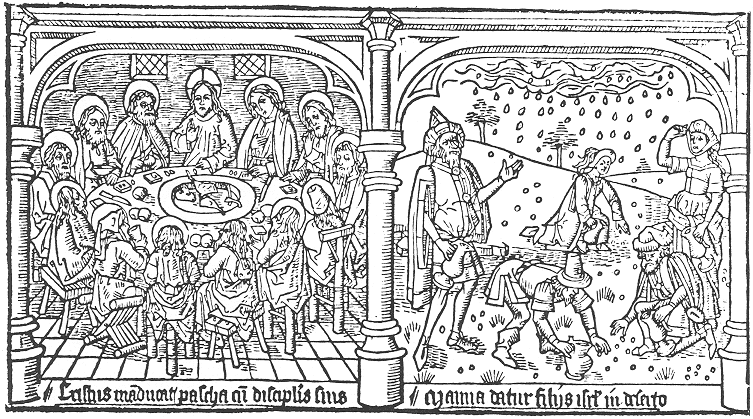
Plate XVI: the Last Supper / Manna in the wilderness:

Plate XXII: the Crucifixion / the Sacrifice of Isaac:
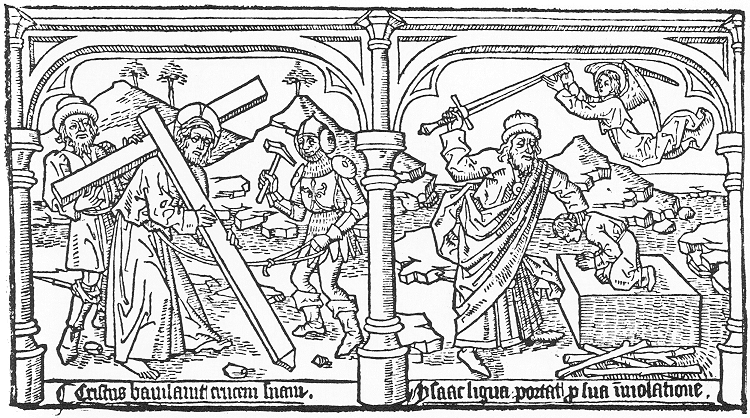
Plate XXVIII: the Resurrection / Samson carrying the gates of Gaza:
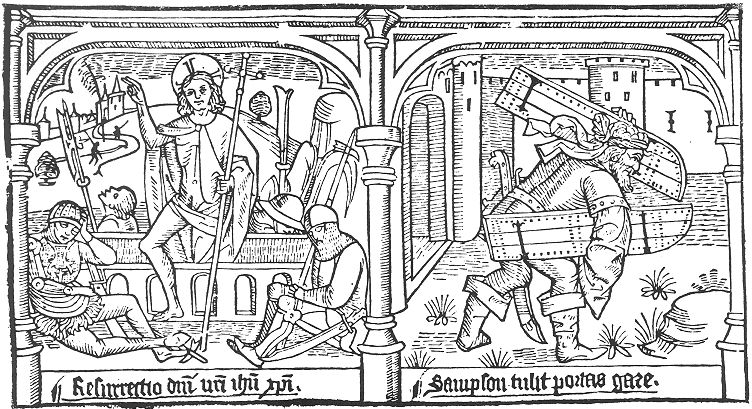
Although the images above pair a NT scene in the left panel with an OT one in the right, not all typologies operate this way. Compare for example the parting of the waters of the Red Sea when Israel leaves Egypt (Ex 14:21) with either the primordial act of dividing water from land in Gen 1:9 or the more obvious parting of the waters of the Jordan River at the other end of the Exodus when Israel enters the Promised Land (Joshua 3:16-17). Consider further the red mark on the lintel of the doors placed by the children of Israel to escape the Passover (Ex 12:13) with the scarlet cord displayed by Rahab in Jericho to escape the destruction of the invading Israelites (Joshua 2:18). Typological thinking pervades the Jewish scriptures even as it connects Jewish with Christian.
Resurrection: clockwise from left, Noah and the dove, Jonah and the whale, David and Michal, Moses and the burning bush
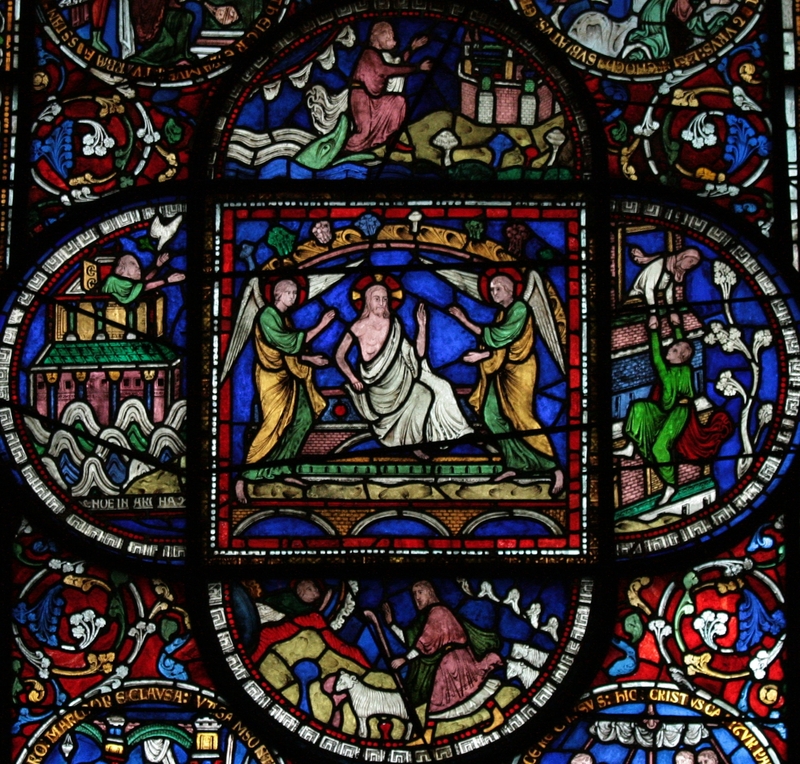
Presentation in the Temple: of Jesus, of Samuel:
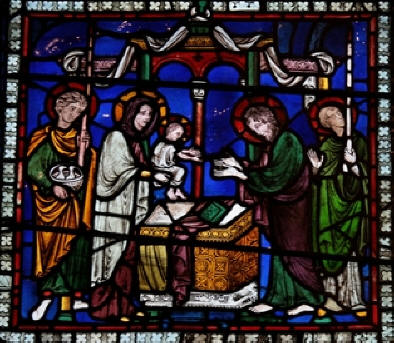
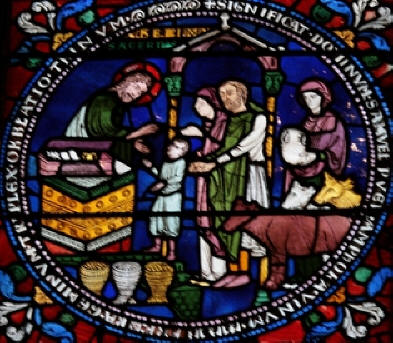
Adoration: of Jesus by the Magi, of Joseph by his brothers:
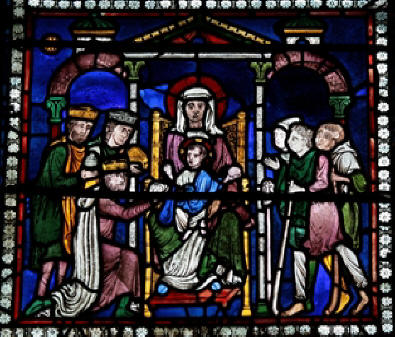
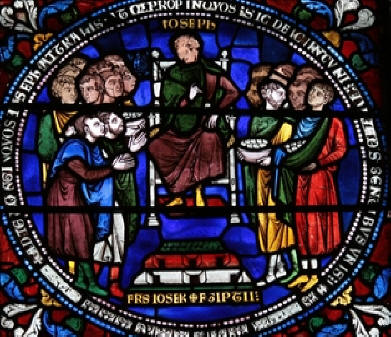
The Annunciation and the Temptation in the Garden:

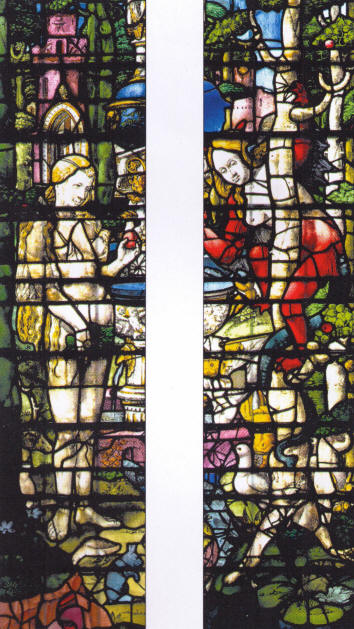
Note that this typological pairing is emphatically NOT allegorical. Erich Auerbach explains why.
You will realize that this method of interpretation involves an approach to human and historical phenomena entirely different from ours. We are apt to consider the events of history and the happenings of everyday life as a continuous development in chronological succession; the figurative interpretation combines two events, causally and chronologically remote from each other, by attributing to them a meaning common to both. Instead of a continuous development, the direction and ultimate result of which is unknown to us, the figurative interpreter purports to know the significance and ultimate result of human history, because this has been revealed to mankind; in this theory, the meaning of history is the fall and redemption of Man, the Last Judgment, and the eternal Kingdom of God. We, on the other hand, are able to explain to a certain extent every single historical fact by its immediate causes and to foresee to a certain extent its immediate consequences, moving so to speak on an horizontal plane; with the figurative approach, on the contrary, in order to explain the significance of a single historical event, the interpreter had to take recourse to a vertical projection of this event on the plane of providential design by which the event is revealed as a prefiguration [type] or a fulfillment [antitype] or perhaps as an imitation of other events. In view of the facts that education and culture were almost entirely ecclesiastical up to the fourteenth century, that the conception of human history, as taught by the church, was dominated by the interpretation of the scriptures, and that this interpretation was entirely figurative and based on the trilogy fall of man, incarnation of Christ, last judgment--in view of all these facts it is evident that the figurative conception of history had to exert a deep and lasting influence on medieval spiritual life even on laymen. Sermons, religious poetry (lyrical and dramatical), church sculpture, that is to say the three most important means of popularizing knowledge in the middle ages, were entirely impregnated with figurism [typology].
May I draw the attention of my readers to the important difference which obtains between figurism and other similar forms of thinking such as allegorism or symbolism. In these patterns, at least one of the two elements combined is a pure sign, but in a figural relation both the signifying and the signified facts are real and concrete historical events. In an allegory of love or in a religious symbol at least one of the terms does not belong to human history; it is an abstraction or a sign. But in the sacrifice of Isaac considered as a figure of the sacrifice of Christ, it is essential, and has been stressed with great vigor, at least in the occidental tradition, that neither the prefiguring nor the prefigured event lose their literal and historical reality by their figurative meaning and interrelation. This is a very important point.
"Typological Symbolism in Medieval Literature," Yale French Studies 9 (1952): 5-6.
All examples here are drawn from the subjects depicted in matched pairs of windows at King's College Chapel, Cambridge, England (1515-1531).
|
TYPE: Moses & the Burning Bush (Exod 3:2-6) Circumcision of Isaac (Gen 21:3-4) Queen of Sheba presenting gifts to Solomon (1 Kings 10:10) Temptation of Eve (Gen 3:1-6) Dedication of Firstborn (Exod 13:2) Jacob's Flight from Esau (Gen 28:5) Naeman Washed in Jordan (2 Kings 5:14) Jacob Tempts Esau to Sell his Birthright (Gen 25:33) Elisha Raises the Shunamite's Son (2 Kings 4:18-37) Triumph of David (1 Sam 17:54, 18:6) Israelites Gather Manna (Exod 16:4-35) Cain and Abel (Gen 4:8) Shimei Cursing David (2 Sam 16:7) Torments of Job (Job 2:7-9) Crowning of Solomon (Song 3:11) Naomi Mourns her Last Son (Ruth 1:5-6) Joseph Cast into the Pit (Gen 37:22) Jonah Spewed out by Whale (Jonah 2:10) Reuben Finds Pit Empty (Gen 37:29) Daniel Found Alive in Lion's Den (Daniel 6:19-23) Daniel Fed in Lion's Den (Daniel 6) Jacob and Joseph meet in Egypt (Gen 46:29-30) Translation of Elijah (2 Kings 2:11-13) Moses Receiving the Tables of the Law (Exod 31:18 - 32:1) |
ANTITYPE: The Nativity (Luke 2:7) Circumcision of Christ (Luke 2:21) Adoration of the Magi (Matt 2:11) The Annunciation (Luke 1:26-38) Presentation of Christ (Luke 2:22) The Flight into Egypt (Matt 2:21) Baptism of Christ (Matt 3:16) Temptation of Christ (Matt 4:1-11) Raising of Lazarus (John 11:43-44) Christ's Entry to Jerusalem (John 12:12-15) The Last Supper (John 13:26) The Betrayal of Christ (Matt 26:49) The Mocking of Christ (Luke 22:64) Scourging of Christ (John 19:2) Christ Crowned with Thorns (John 19:2) Lamentation of Christ by Mary (Trad.) Entombment of Christ (Matt 27:60) Christ's Resurrection (Matt 28:2) Three Marys at the Tomb (Mark 16:2) Christ Appears to Magdalene (John 20:14) Supper at Emmaus (Luke 24:30-31) Christ Appears to the Apostles (John 20:19-20) The Ascension (Acts 1:9) Pentecost (Acts 2:1-4) |